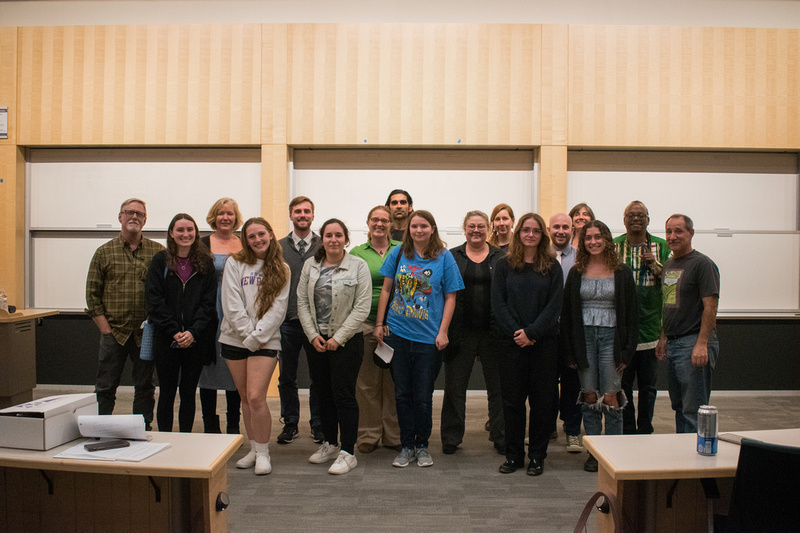Education alumni return to their alma mater to share strategies for teaching climate solutions

SUNY New Paltz convened a panel of six local Hudson Valley K-12 teachers, five of whom are New Paltz School of Education alumni, for a conversation about ways of integrating lessons and activities about climate crisis and climate action into coursework for students of different ages.
The event, held on Wednesday, Oct. 26, offered current New Paltz students a chance to hear from fellow Hawks working in nearby districts, and how they are navigating challenging subject matter in their classrooms.
The alumni panelists were: Wallkill High School physics teacher Samrat Pathania ’13 (Physics/Mathematics; Adolescent Education); Bennett Elementary School social studies teacher Karen Hadley ’00g (Elementary Education); Woodstock Day School environmental sciences teacher Glenn Rubic ’82 (Geology); and New Paltz Middle School art teacher Mary Jane Nusbaum ’06g (MFA Art Studio/Printmaking) and science teacher Bryan Krebs ’15 ’18g (Environmental/Organismal Biology; Adolescent Education).
They were joined by Eugene Foley, a math teacher from Roy C. Ketcham High School in Wappingers Falls, New York.
This event was part of a series organized by Birgitta Cockburn ’23 (Environmental Science), part of New Paltz’s student sustainability ambassador team, for each school on campus to weigh in on the urgency of climate change.
“This semester, I thought it would be a really good idea to have a panel making climate action more available for people to learn about,” said Cockburn. “It’s an extremely important issue, and we have the perfect atmosphere here at New Paltz for this kind of forum.”
Here are some of the different ways the panelists tackle teaching about climate change that were passed on to future teachers in the audience:
“I want to bring climate change solutions to my students in a way that feels empowering, so that they don’t feel weighed down by the scale of the crisis,” said Pathania. “I use concepts from physics to explain everyday climate change solutions that can be implemented in the home.”
“I show my students a video which puts in simple terms what is happening the planet and in our solar system, and that it’s something largely manmade that has been going on for centuries,” said Hadley. “Then I present a large number of plastic bottles to the class, and the kids pick up on how plastic is contributing to this global problem.”
“Middle school kids are especially aware of climate change and are very much worried about it,” said Krebs, “so it’s important for me to talk about solutions in mathematic terms.”
“When I need the kids to be able to write a linear equation, I try to incorporate some sort of climate solution in there so they can apply the math to this current issue,” said Foley.
For some of the alumni on the panel, the event was an opportunity to reflect on how New Paltz ignited their passion for environmentalism:
“My first invitation into geology was going up to Ontario and spending three weeks touring the Economic Geology of Ontario mining corporations,” said Rubic. “From that moment on, I was hooked.”
“We learned of how Hudson River School artists brought in environmental themes in their artwork, which is something I like bringing to my students,” said Nussbaum. “Telling the stories of these artists as well as some current artists focused on environmentalism is a huge part of what I teach my students.”
The panel was made possible by both the Office of Campus Sustainability and the student Sustainability Ambassador Carbon Neutrality Team, and was sponsored by the School of Education, the Department of Teaching and Learning, and the Office of Alumni Relations.
Visit the Sustainability Ambassadors website to learn more about student efforts to integrate social, economic and environmental sustainability across the campus community.
